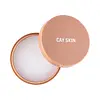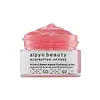What's inside
What's inside
 Key Ingredients
Key Ingredients

 Benefits
Benefits

 Concerns
Concerns

 Ingredients Side-by-side
Ingredients Side-by-side

Polybutene
Hydrogenated Polyisobutene
EmollientDiisostearyl Malate
EmollientDipentaerythrityl Tetrahydroxystearate/Tetraisostearate
Skin ConditioningSynthetic Beeswax
Emulsion StabilisingGlyceryl Behenate/Eicosadioate
EmollientSynthetic Wax
AbrasivePhytosteryl/Isostearyl/Cetyl/Stearyl/Behenyl Dimer Dilinoleate
Skin ConditioningButyrospermum Parkii Butter
Skin ConditioningSilica Silylate
EmollientHelianthus Annuus Seed Oil
EmollientVanillin
MaskingPhytosteryl/Octyldodecyl Lauroyl Glutamate
Skin ConditioningIsostearyl Alcohol
EmollientBoron Nitride
AbsorbentSorbitan Sesquioleate
EmulsifyingAloe Barbadensis Leaf Extract
EmollientCalendula Officinalis Extract
Skin ConditioningTocopheryl Acetate
AntioxidantMalic Acid
BufferingWater
Skin ConditioningRicinus Communis Seed Oil
MaskingSodium Hyaluronate
HumectantPanthenol
Skin ConditioningHydrogenated Castor Oil
EmollientTocopherol
AntioxidantChondrus Crispus Extract
Skin ConditioningHibiscus Sabdariffa Flower Extract
Skin ConditioningHydrolyzed Chondrus Crispus Extract
Skin ConditioningMoringa Oleifera Seed Extract
Skin ConditioningCitric Acid
BufferingPolybutene, Hydrogenated Polyisobutene, Diisostearyl Malate, Dipentaerythrityl Tetrahydroxystearate/Tetraisostearate, Synthetic Beeswax, Glyceryl Behenate/Eicosadioate, Synthetic Wax, Phytosteryl/Isostearyl/Cetyl/Stearyl/Behenyl Dimer Dilinoleate, Butyrospermum Parkii Butter, Silica Silylate, Helianthus Annuus Seed Oil, Vanillin, Phytosteryl/Octyldodecyl Lauroyl Glutamate, Isostearyl Alcohol, Boron Nitride, Sorbitan Sesquioleate, Aloe Barbadensis Leaf Extract, Calendula Officinalis Extract, Tocopheryl Acetate, Malic Acid, Water, Ricinus Communis Seed Oil, Sodium Hyaluronate, Panthenol, Hydrogenated Castor Oil, Tocopherol, Chondrus Crispus Extract, Hibiscus Sabdariffa Flower Extract, Hydrolyzed Chondrus Crispus Extract, Moringa Oleifera Seed Extract, Citric Acid
Hydroxystearic/Linolenic/Oleic Polyglycerides
EmollientRicinus Communis Seed Oil
MaskingPolyhydroxystearic Acid
EmulsifyingHelianthus Annuus Seed Oil
EmollientAgave Tequilana Leaf Extract
AstringentPrunus Armeniaca Kernel Oil
MaskingCocos Nucifera Oil
MaskingHelianthus Annuus Seed Wax
Skin ConditioningHydrogenated Castor Oil
EmollientCapryloyl Glycerin/Sebacic Acid Copolymer
Skin ConditioningCopernicia Cerifera Wax
Aloe Barbadensis Leaf Extract
EmollientTocopherol
AntioxidantSodium Hyaluronate
HumectantSimmondsia Chinensis Seed Oil
EmollientArnica Montana Flower Extract
MaskingBorago Officinalis Extract
EmollientCalendula Officinalis Flower Extract
MaskingChamomilla Recutita Flower Extract
MaskingSalvia Officinalis Leaf Extract
CleansingSalix Alba Extract
Skin ConditioningVaccinium Uliginosum Berry Extract
Skin ConditioningPrunus Davidiana Extract
AntioxidantArctostaphylos Uva Ursi Leaf Extract
Skin ConditioningMalva Officinalis Flower Extract
Skin ConditioningStevia Rebaudiana Leaf/Stem Extract
MaskingCitrus Limon Peel Oil
MaskingRosa Damascena Flower Oil
MaskingMenthyl Lactate
MaskingEclipta Prostrata Extract
Skin ConditioningMelia Azadirachta Leaf Extract
Skin ConditioningMoringa Oleifera Seed Oil
EmollientCitral
PerfumingLimonene
PerfumingHydroxystearic/Linolenic/Oleic Polyglycerides, Ricinus Communis Seed Oil, Polyhydroxystearic Acid, Helianthus Annuus Seed Oil, Agave Tequilana Leaf Extract, Prunus Armeniaca Kernel Oil, Cocos Nucifera Oil, Helianthus Annuus Seed Wax, Hydrogenated Castor Oil, Capryloyl Glycerin/Sebacic Acid Copolymer, Copernicia Cerifera Wax, Aloe Barbadensis Leaf Extract, Tocopherol, Sodium Hyaluronate, Simmondsia Chinensis Seed Oil, Arnica Montana Flower Extract, Borago Officinalis Extract, Calendula Officinalis Flower Extract, Chamomilla Recutita Flower Extract, Salvia Officinalis Leaf Extract, Salix Alba Extract, Vaccinium Uliginosum Berry Extract, Prunus Davidiana Extract, Arctostaphylos Uva Ursi Leaf Extract, Malva Officinalis Flower Extract, Stevia Rebaudiana Leaf/Stem Extract, Citrus Limon Peel Oil, Rosa Damascena Flower Oil, Menthyl Lactate, Eclipta Prostrata Extract, Melia Azadirachta Leaf Extract, Moringa Oleifera Seed Oil, Citral, Limonene
Ingredients Explained
These ingredients are found in both products.
Ingredients higher up in an ingredient list are typically present in a larger amount.
Aloe Barbadensis Leaf Extract is an extract of the leaves of the aloe, Aloe barbadensis, Liliaceae.
Aloe is one of the most well-known natural soothing ingredients, and for good reason. It’s full of water and has a cooling, calming effect on the skin, especially when it’s sunburned, itchy, or irritated. Aloe also helps your skin stay hydrated and smooth by mimicking what healthy skin naturally produces. On top of that, it contains vitamins and nutrients that support skin recovery.
It doesn’t protect you from the sun, but it can help your skin bounce back after too much time in it.
Let’s get into the details:
Aloe contains antioxidant Vitamins A, C, and E, which help fight off free radicals (unstable molecules from things like pollution that can damage your skin).
It’s also rich in polysaccharides, which are natural sugars that help hydrate the skin by acting like the skin’s own moisturizing agents. These, along with other sugars like monosaccharides, help form a protective barrier that locks in moisture.
Aloe works as both a humectant and an emollient. That means it draws water into the skin (humectant) and helps trap it there (emollient), making it an effective natural moisturizer.
You’ll also find a mix of other skin-supporting ingredients in aloe, including folic acid, choline, calcium, amino acids, fatty acids, and even Vitamin B12.
Out of the 420+ species of aloe, Aloe barbadensis is the most widely used in skincare products thanks to its gentle yet effective properties.
There are over 420 species of aloe but Aloe Barbadensis is the most commonly used for topical products.
Learn more about Aloe Barbadensis Leaf ExtractHelianthus Annuus Seed Oil is the oil derived from the seeds of a Sunflower. Sunflower seed oil is non-fragrant. It is an emollient, meaning it helps to soften the skin.
Sunflower seed oil contains many fatty acids. The fatty acids found in sunflower seeds include (from highest amount to least): linoleic acid, myristic acid, palmitic acid, stearic acid, arachidic acid, oleic acid, and linolenic acid.
These fatty acids help the skin create ceramides. Ceramides play a role in repairing the skin barrier.
Helianthus Annuus Seed Oil helps moisturize the skin. This in turn helps the skin look more rejuvenated and smoother.
Sunflowers are rich in vitamin E.
Historians believe Indigenous cultures of North America domesticated sunflowers before corn. Thus they relied on sunflower oil for a variety of uses. One such use is moisturizing skin and hair.
Sunflower seed oil may not be fungal acne safe. We recommend speaking with a professional if you have any concerns.
Learn more about Helianthus Annuus Seed OilHydrogenated Castor Oil is created by adding hydrogen to castor oil. This helps stabilize the castor oil and raises the melting point. At room temperature, hydrogenated castor oil is solid.
Castor Oil helps moisturize the skin. It is rich in a fatty acid called ricinoleic acid. This fatty acid helps prevent moisture loss on the skin. This helps keep your skin soft and hydrated. Ricinoleic acid also has anti-inflammatory and pain reducing properties.
As a wax-like substance, Hydrogenated Castor Oil acts as an emollient. Emollients help keep your skin stay soft and smooth by creating a barrier. This barrier helps trap moisture.
Hydrogenated Castor Oil may not be fungal-acne safe. We recommend speaking with a professional.
Learn more about Hydrogenated Castor OilRicinus Communis Seed Oil is the INCI name for castor oil.
Castor Oil helps moisturize the skin. It is rich in a fatty acid called ricinoleic acid. This fatty acid helps prevent moisture loss on the skin. This helps keep your skin soft and hydrated. Ricinoleic acid also has anti-inflammatory and pain reducing properties.
Besides hydrating the skin, castor oil is also used to hydrate hair. By keeping the hair shaft moisturized, breakage is decreased. More studies are needed to show castor oil's effective on stimulating hair growth.
Castor oil is created by cold-pressing castor seeds and then purifying the oil with heat. It was used in Ancient Egypt as fuel in lamps and to help treat eye irritation.
The term 'fragrance' is not regulated in many countries. In many cases, it is up to the brand to define this term. For instance, many brands choose to label themselves as "fragrance-free" because they are not using synthetic fragrances. However, their products may still contain ingredients such as essential oils that are considered a fragrance.
Learn more about Ricinus Communis Seed OilSodium Hyaluronate is hyaluronic acid's salt form. It is commonly derived from the sodium salt of hyaluronic acid.
Like hyaluronic acid, it is great at holding water and acts as a humectant. This makes it a great skin hydrating ingredient.
Sodium Hyaluronate is naturally occurring in our bodies and is mostly found in eye fluid and joints.
These are some other common types of Hyaluronic Acid:
Learn more about Sodium HyaluronateTocopherol (also known as Vitamin E) is a common antioxidant used to help protect the skin from free-radicals and strengthen the skin barrier. It's also fat soluble - this means our skin is great at absorbing it.
Vitamin E also helps keep your natural skin lipids healthy. Your lipid skin barrier naturally consists of lipids, ceramides, and fatty acids. Vitamin E offers extra protection for your skin’s lipid barrier, keeping your skin healthy and nourished.
Another benefit is a bit of UV protection. Vitamin E helps reduce the damage caused by UVB rays. (It should not replace your sunscreen). Combining it with Vitamin C can decrease sunburned cells and hyperpigmentation after UV exposure.
You might have noticed Vitamin E + C often paired together. This is because it is great at stabilizing Vitamin C. Using the two together helps increase the effectiveness of both ingredients.
There are often claims that Vitamin E can reduce/prevent scarring, but these claims haven't been confirmed by scientific research.
Learn more about Tocopherol